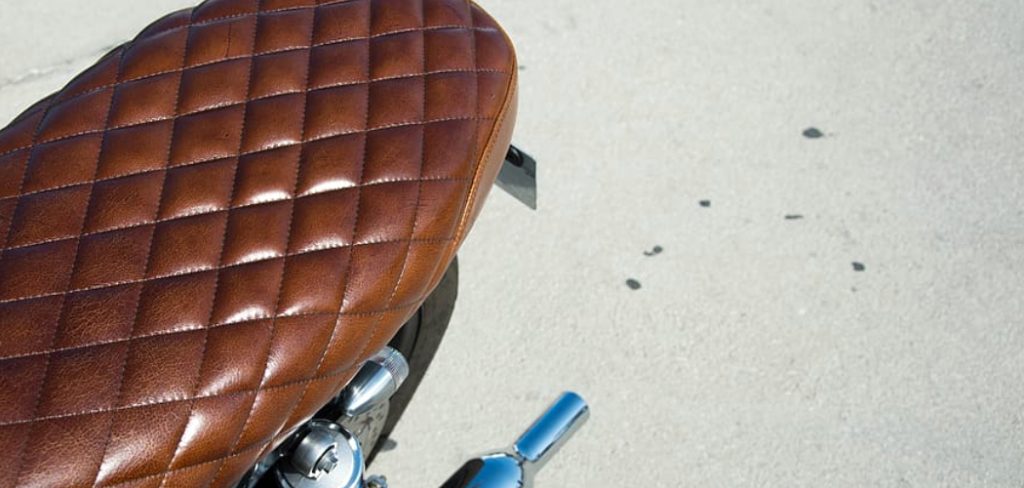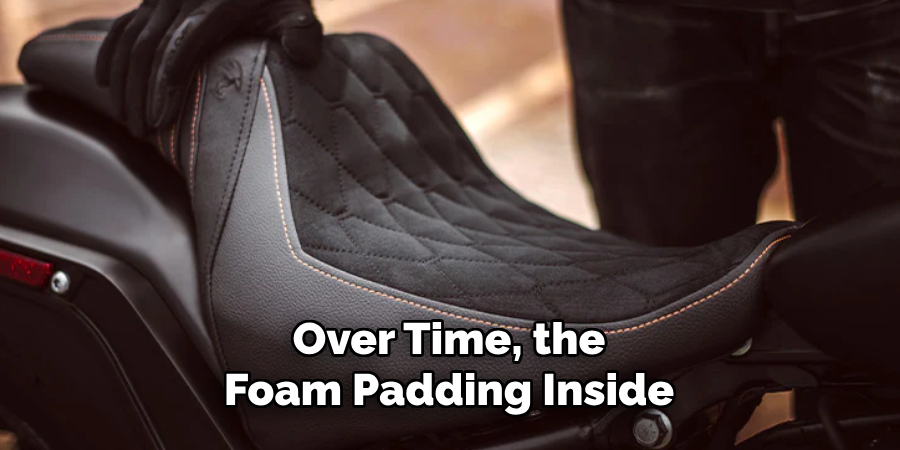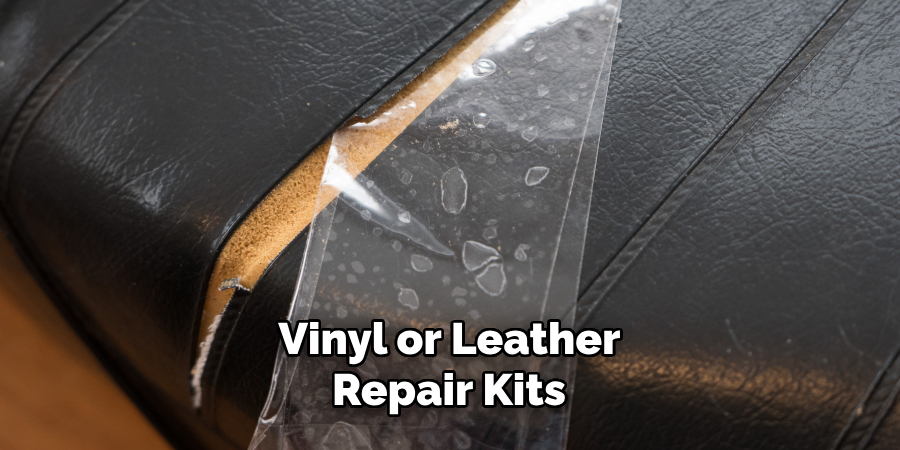A damaged or uncomfortable motorcycle seat can make your rides unpleasant and even cause physical discomfort over time. Whether the seat is ripped, worn out, or simply not providing enough support, fixing it yourself can be a cost-effective and rewarding solution. This guide will walk you through how to fix a motorcycle seat, ensuring a more comfortable and enjoyable riding experience.

Common Problems with Motorcycle Seats
Motorcycle seats can face a variety of issues over time due to regular use, exposure to the elements, and general wear and tear. Here are some of the most common problems:
- Rips and Tears – Frequent usage or accidental abrasions can lead to cracks or holes in the seat cover, exposing the foam underneath to further damage and moisture.
- Worn-Out Foam Padding – Over time, the foam padding inside the seat may wear out, reducing its ability to provide sufficient cushioning and support.
- Loose or Damaged Seat Upholstery – Prolonged exposure to UV rays, heat, and rain can cause the upholstery to become brittle, fade, or loosen from the seat frame.
- Water Damage – If a seat is not properly sealed or has cracks, water can seep in, leading to mold or mildew in the foam padding.
- Seat Misalignment – Improper mounting or an aging seat frame can result in the seat becoming loose or misaligned, affecting rider comfort and safety.

By identifying these issues early, you can take the necessary steps to repair or replace components, ensuring your motorcycle seat remains in good condition.
Understanding Motorcycle Seat Problems For How to Fix a Motorcycle Seat
To effectively fix a motorcycle seat, it is essential to understand the root causes of the common issues. Over time, a combination of environmental factors, frequent use, and improper maintenance can contribute to the deterioration of your motorcycle seat. For instance, prolonged exposure to sunlight and rain can break down the materials, leading to cracks in the cover or foam damage. Additionally, inadequate cleaning or neglect can allow dirt and moisture to accumulate, accelerating wear and tear. Another potential issue lies in the quality of materials used in the seat’s construction; cheaper materials may not last as long or hold up under regular use. Being aware of these contributing factors can help you take preventive measures and ensure a more durable repair when addressing seat problems.
1. Repair Small Tears with Vinyl or Leather Patches
Small tears in a motorcycle seat can be easily fixed using vinyl or leather repair kits. Start by cleaning the damaged area with a mild detergent to remove dirt and oils. Cut a patch slightly larger than the tear and use adhesive from the repair kit to attach it. Press the patch firmly and let it cure according to the kit’s instructions. This method is ideal for minor damage and ensures the seat remains waterproof.
2. Use a Seat Cover

If the seat cover is extensively worn or damaged, consider purchasing a replacement cover. Measure your seat to ensure a proper fit, then remove the old cover by prying off the staples or clips. Position the new cover over the foam and secure it with a staple gun or clips, ensuring it’s taut and wrinkle-free. Seat covers come in various materials, allowing you to customize the look and feel of your motorcycle.
3. Patch the Foam
Damaged foam can make a seat uncomfortable. To repair it, remove the seat cover and inspect the foam for cracks or holes. Use foam adhesive to bond any separated pieces or fill gaps with new foam. Trim the new foam to match the seat’s contours using a sharp knife or electric carving tool. Smooth the surface with sandpaper before reattaching the cover. This method restores comfort and ensures even weight distribution.
4. Replace the Foam Entirely
For seats with severely degraded foam, replacing it entirely is often the best option. Remove the old foam and measure the seat pan to cut a new piece of foam to size. High-density foam is recommended for durability and support. Attach the foam to the seat pan using adhesive spray, then shape it to your desired contours. Cover the foam with the original or a new seat cover for a refreshed look.
5. Reinforce the Seat Pan

A damaged seat pan can compromise the seat’s structure. Inspect the pan for cracks, rust, or loose bolts. Use epoxy or fiberglass repair kits to fix cracks and reinforce weak areas. For metal pans, sand off rust and apply a rust-preventive coating. Secure loose bolts and ensure all mounting points are intact. A sturdy seat pan is essential for rider safety and comfort.
6. Add Gel Pads for Extra Comfort
If your seat feels too hard, adding a gel pad can improve comfort. Remove the seat cover and foam, then cut a cavity in the foam to fit the gel pad. Place the pad in the cavity and cover it with a thin layer of foam to maintain a smooth surface. Reattach the seat cover securely. Gel pads absorb vibrations and distribute weight more evenly, making long rides more enjoyable.
7. Reupholster the Seat
For a complete makeover, consider reupholstering your motorcycle seat. Remove the old cover and foam, then clean and inspect the seat pan. Cut new foam and shape it as desired. Select upholstery material that matches your style and riding needs, such as vinyl for durability or leather for a premium look. Secure the material tightly to the seat pan using a staple gun. Reupholstering allows for full customization and restores the seat’s appearance.
8. Install Heated Seat Elements
If you often ride in cold weather, installing heated seat elements can enhance comfort. Purchase a motorcycle-specific heating kit and follow the instructions to install the heating elements between the foam and seat cover. Connect the wiring to your motorcycle’s electrical system, ensuring proper insulation and secure connections. This upgrade adds luxury and functionality to your seat.
9. Seal the Seat for Waterproofing
Water damage can degrade foam and cause mold or mildew. To waterproof your seat, use a spray-on sealant designed for upholstery. Remove the seat cover and apply the sealant to both the foam and the underside of the cover. Let it dry completely before reassembling the seat. Regular waterproofing ensures longevity and protects your seat from the elements.
10. Replace the Entire Seat

If your motorcycle seat is beyond repair or you’re looking for an upgrade, replacing the entire seat may be the best solution. Look for aftermarket or OEM seats compatible with your motorcycle model. Installing a new seat is straightforward—detach the old one, align the new seat with the mounting points, and secure it with bolts. New seats often come with improved ergonomics and materials, enhancing your riding experience.
Things to Consider When Repairing or Replacing a Motorcycle Seat
When deciding how to repair or replace your motorcycle seat, there are several factors to keep in mind to ensure the best outcome:
- Budget
Determine how much you’re willing to spend on repairs or replacements. Minor repairs, such as patching tears or adding foam, are often cost-effective, while a complete seat replacement or reupholstery may require a larger investment.
- Material Quality
The durability and comfort of your seat heavily depend on the quality of materials used. Opt for high-density foam, weather-resistant vinyl, or genuine leather for long-lasting performance.
- Riding Needs
Consider your typical riding conditions and needs. For instance, if you frequently ride long distances, adding gel pads or upgrading to a seat designed for touring comfort might be a priority. For wet climates, waterproofing should be emphasized.
- Aesthetic Preferences
The seat contributes to your motorcycle’s overall appearance. Choose materials and designs that complement your bike’s style, whether you prefer a sleek, modern look or a classic vintage vibe.
- DIY Versus Professional Help
Assess whether you have the tools and skills needed for the repair or replacement. Simple fixes can often be done at home, while extensive repairs or custom reupholstering may require the expertise of a professional.
- Compatibility
Ensure that any replacement seat or parts you purchase are compatible with your motorcycle model. Refer to the manufacturer’s specifications for proper fitment.
By carefully considering these factors, you can make informed decisions that enhance the comfort, functionality, and aesthetics of your motorcycle seat.
Conclusion
Repairing or replacing your motorcycle seat can significantly improve your overall riding experience, offering enhanced comfort, safety, and style. Whether you choose to make small adjustments, such as patching tears or adding gel pads, or undertake a full seat replacement, there are solutions suitable for every budget and need. By using high-quality materials, tailoring the seat to your riding preferences, and ensuring proper maintenance, you can extend the lifespan of your seat and enjoy a more comfortable ride. Take the time to assess your options carefully, and don’t hesitate to seek professional help for complex restorations. Thanks for reading our blog post on how to fix a motorcycle seat! We hope you found it helpful and informative.
